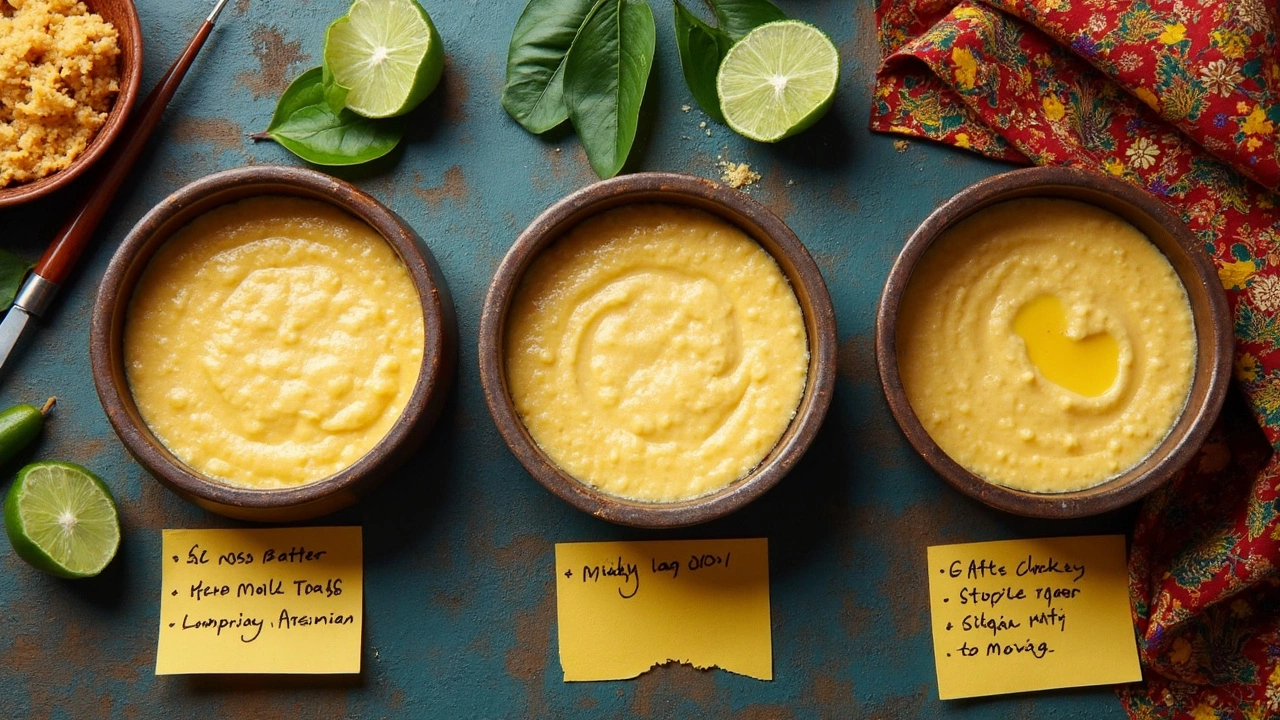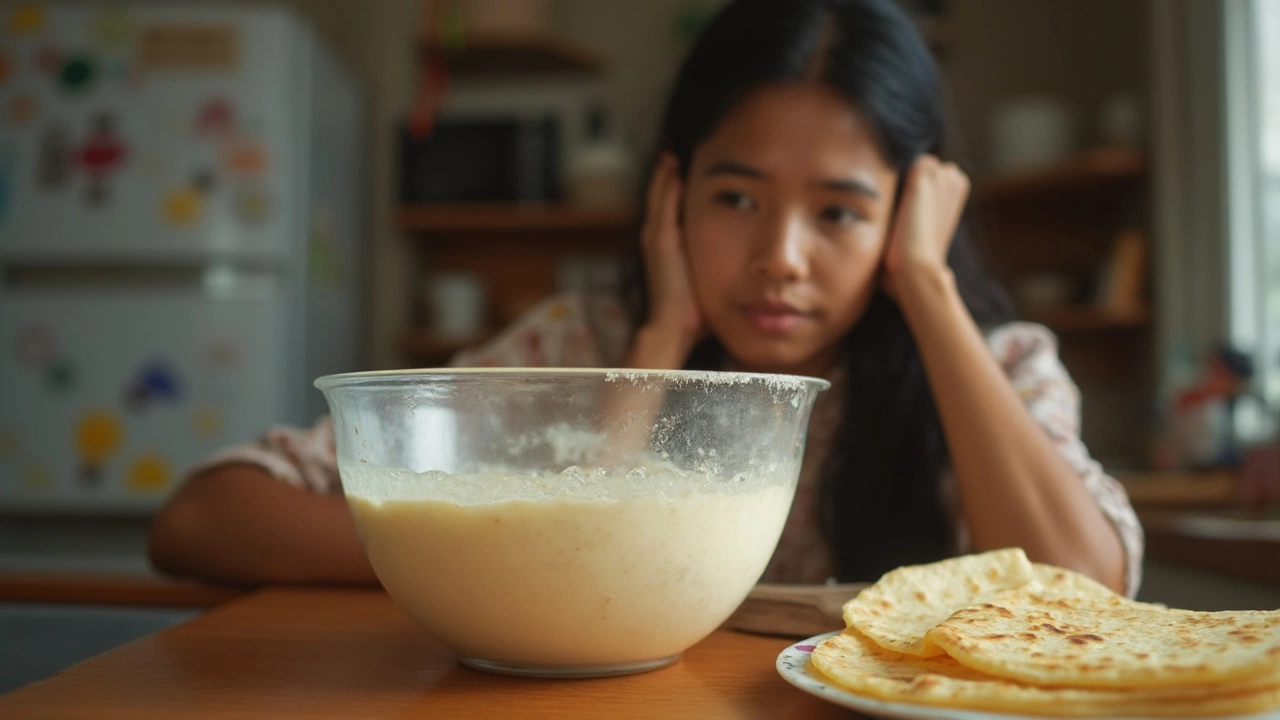So, you found a container of dosa batter pushed to the back of your fridge, and the math says it’s about two weeks old. The big question: is it safe to use, or is it headed straight for the trash?
Dosa batter is kind of like yogurt—it’s alive, thanks to all the good bacteria doing their thing. Most people stick to batter that’s a few days old, but stretching it to two weeks? That’s not unheard of, but you need to watch out for a few key things before firing up the pan.
Smell it first. If you get a whiff that reminds you of nail polish remover or something really funky (not the happy, sour-tangy smell you expect), it’s best not to gamble. Mold? That’s an immediate no-go. You’ll probably also notice that old batter gets sourer and thinner with time. Some folks in South India even like the tang that comes with older batter, but there’s a fine line between tasty and trash-worthy.
- How Long Does Dosa Batter Last?
- Signs Your Batter Has Gone Bad
- Taste and Texture Changes After Two Weeks
- Making Old Batter Work: Kitchen Hacks
- Storing Dosa Batter Safely
How Long Does Dosa Batter Last?
If you’re storing homemade dosa batter in the fridge at about 4°C (39°F), expect it to last at least 4 to 6 days without much change in taste or smell. After a week, you’ll notice it gets tangier and the texture may not be as bouncy or airy as day one. But two weeks? That’s definitely stretching it, and you have to be extra careful.
Here’s the thing—fermented batter is less likely to grow harmful bacteria right away, but time and temperature still matter. A clean container, tight lid, and a fridge that runs cold (not those rickety ones that freeze things on the back wall and feel warm in the front) make a real difference. If the batter was handled with clean spoons and never left at room temp for too long, it will last longer. Each time you dip in with a dirty ladle or leave the tub open, you’re shortening its lifespan.
- Store only what you need daily in a smaller container and keep the rest untouched for better shelf life.
- If you’re making a big batch, portion it out and freeze half. Dosa batter freezes well for up to one month—thaw it overnight in the fridge, and you’re good to go.
- Adding a pinch of salt to the unfermented batter before storing helps slow down souring, so you get a milder flavor for longer.
If you’ve got batter that’s over 10 days old, always trust your senses. Smell, taste, and inspect. No one likes a side of stomach troubles with their dosas.
Signs Your Batter Has Gone Bad
When it comes to leftover dosa batter, there’s a big difference between well-fermented and just plain spoiled. If you’re not sure what to check, here’s how you can tell if it’s safe to use or better off tossed.
- Unpleasant Smell: Good dosa batter will smell sour but still fresh. If it smells like chemicals (think paint, nail polish remover, or rotten eggs), that’s a bad sign.
- Mold and Discoloration: Black, green, or pink patches mean mold is in town. Even tiny spots mean you need to throw out the whole batch, no second chances.
- Unusual Texture: Watery separation is normal — just stir it. But if you see thick, slimy strings or the batter is really clumpy in a weird way, it’s probably over the edge.
- Taste Test: If you’re brave, a tiny taste is okay. Anything bitter, metallic, or way more sour than usual? Time to say goodbye.
A microbiology study in 2022 found that most homemade dosa batter, stored in the fridge, starts to show visible spoilage between 10 and 15 days. Here’s what food safety experts look for and why:
| Sign | What It Means |
|---|---|
| Sour, but pleasant smell | Still fermenting, usually safe |
| Chemical/foul smell | Possible yeast or bacteria issues |
| Mold (any color) | Unsafe, discard immediately |
| Strange consistency | May be spoiled or contaminated |
Food scientist Dr. Shalini Nair says,
"Sourness is normal, but off-odors, fuzz, or discoloration mean your dosa batter is no longer safe. Always trust your nose and eyes. Don’t take risks with old batter."
It’s tempting to scrape off mold and try to salvage what’s left, but that’s just not safe. Mold can produce toxins that seep into the entire batch, even if you can’t see them. If something feels off, trust your instincts. It’s better to start fresh than get sick.

Taste and Texture Changes After Two Weeks
When dosa batter sits in your fridge for up to two weeks, a few things start to happen—some are harmless, others are warning signs. Most folks notice the batter gets a lot sourer. That’s just the lactic acid bacteria doing their job for a longer time. If you loved the tangy flavor on day four, at day fourteen it’ll likely taste way sharper, which isn’t for everyone. Some say that extra sour taste is great for making uttapam or slightly thicker dosas, but it doesn’t work for crispy paper dosas.
The texture also changes. Fresh batter is thick but pourable, and it gives you soft, golden dosas. After two weeks, it usually turns runny and sometimes gets bubbles on top. That runniness means it spreads faster on the pan, but you might end up with thin, floppy dosas instead of the lacy but sturdy ones you want. You can stir in a little rice flour or semolina to thicken it up if you need to rescue it.
According to Chef Nandita Iyer, a well-known food writer and nutritionist,
"Old dosa batter will get sourer each day, but as long as it smells fresh-sour and not pungent, it’s still usable for savory pancakes and uttapams. But if it splits or looks grey, toss it."
Here’s what really matters for two-week-old dosa batter:
- Batter gets extra tangy—some love it, some don’t
- It often turns watery with more bubbles
- Dosas get thinner, sometimes too floppy
- Sourness pairs okay with spicy fillings but overpowers mild potato masala
If you love numbers, check this out—batter kept in the fridge (below 4°C) showed these typical results over 14 days:
| Day | Sourness (pH) | Typical Consistency | Dosa Quality |
|---|---|---|---|
| 1 | 5.8 | Thick, smooth | Soft, pillowy |
| 7 | 4.8 | Medium | Crispy edges, slight tang |
| 14 | 4.3 | Thin, bubbly | Very sour, sometimes floppy |
If your batter has gone way too sour, you can balance it by mixing in a little fresh batter or adding half a teaspoon of sugar to take the edge off. Just don’t serve it to anyone sensitive to tang, or to young kids—the flavor is intense, and in rare cases, the strong acidity can upset people’s stomachs.
Making Old Batter Work: Kitchen Hacks
If you’re not ready to toss that old dosa batter just yet, you can actually get a bit creative and salvage it for a decent meal. Dosa batter isn’t cheap if you factor in time and effort, so using every drop counts. Here’s what you can try if your dosa batter is hitting that two-week mark but hasn’t gone totally off.
First, check the texture. Older batter often gets runny because fermentation breaks it down. If it’s too thin, sprinkle in a tablespoon or two of rice flour or semolina (rava), mix it well, and let it sit for 10–15 minutes. This bulks it up and helps dosa hold its shape in the pan.
Flavor can get super sour the longer it sits, so if you don’t like that tang, try adding a pinch of sugar, a splash of milk, or even a couple spoonfuls of fresh batter (if you have any left from a new batch). Another trick: make uttapam or paniyaram instead of plain dosas—these work better with sourer batter since you can pile on veggies and spices.
- Turn it into savory pancakes by tossing in chopped onions, chilies, cilantro, and grated carrots.
- Use old batter as a base for instant appam—just stir in a pinch of baking soda and a teaspoon of sugar before cooking.
- If you notice too much water on top, drain it off before mixing; excess water will make dosas rubbery.
Don’t forget: two-week-old batter cooks fast, so keep an eye on the heat, or you’ll end up with burnt edges. And always use a clean spoon each time you scoop out batter to keep it from picking up fridge smells or bacteria.
| Common Issues | Quick Fixes |
|---|---|
| Batter too runny | Add rice flour or semolina |
| Gets too sour | Mix in sugar, milk, or fresh batter |
| Batter separated (water on top) | Pour off excess water and stir gently |
| Doesn’t rise/fluff up | Add a pinch of baking soda before cooking |
Some moms in Chennai even let batter go over two weeks and swear it makes the crispiest dosas—just be smart, check for spoilage, and adjust the flavors. No reason to waste batter if it’s still hanging in there!

Storing Dosa Batter Safely
Keeping dosa batter safe and fresh isn’t hard, but a few habits go a long way. First off, always refrigerate your dosa batter as soon as it’s done fermenting. If you leave it out — especially in hot weather — it goes sour and can spoil fast. The fridge slows down the souring process and keeps bad bacteria in check.
Use a clean container every single time. Bacteria from dirty spoons or containers get into the batter and make it go bad quicker. Airtight containers work best. If you’re putting a lot of batter in the fridge, try dividing it into smaller jars. That way, every time you scoop some out, you’re not exposing the whole stash to air or germs.
It sounds basic, but always use a clean spoon. Double-dipping or tasting straight from the container means bacteria from your mouth end up in the batter. That’s a one-way ticket to spoilage.
- If your fridge is running warm (above 4°C or 40°F), the batter goes off much faster. Cold is key.
- If you won’t use the batter within five days, try freezing it in small portions. Thaw in the fridge overnight before using, and give it a good mix before making dosas.
- Older batter gets sour. If you like milder dosas, make smaller batches more often instead of storing one big batch for weeks.
Most people overlook labels, but date your containers with a piece of tape. You’ll thank yourself later, when you’re standing in front of the fridge trying to remember if that batch was from yesterday… or last week.
Finally, keep the batter away from strong-smelling foods like onions or fish. Dosa batter absorbs odors easily, and the last thing you want on your dosa is a hint of last night’s leftovers!
